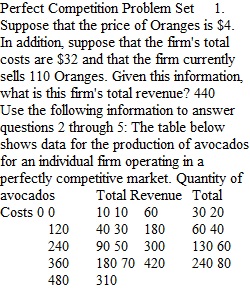


Q Perfect Competition Problem Set 1. Suppose that the price of Oranges is $4. In addition, suppose that the firm's total costs are $32 and that the firm currently sells 110 Oranges. Given this information, what is this firm's total revenue? Use the following information to answer questions 2 through 5: The table below shows data for the production of avocados for an individual firm operating in a perfectly competitive market. Quantity of avocados Total Revenue Total Costs 0 0 10 10 60 30 20 120 40 30 180 60 40 240 90 50 300 130 60 360 180 70 420 240 80 480 310 2. Given this data, complete the table: Quantity of avocados Marginal Revenue (MR) Marginal Costs (MC) Profit 0 - - 10 20 30 40 50 60 70 80 3. At what quantity does this firm maximize its profit? NOTE: If there are two quantities with the same level of profits, pick the larger of the two quantities! 4. What is marginal revenue at the profit maximizing quantity? NOTE: If there are two quantities with the same level of profits, pick the larger of the two quantities! 5. What is marginal cost at the profit maximizing quantity? NOTE: If there are two quantities with the same level of profits, pick the larger of the two quantities! ? 6. The graph below shows cost curves for a firm operating in a perfectly competitive market. Suppose that the equilibrium price is $21. This firm is earning a. Profits b. Zero Economic Profits (Break-even point) c. Losses ? 7. The graph below shows cost curves for a typical firm operating in a perfectly competitive market. Suppose that the equilibrium price is $12. What will happen in this market in the long run? a. New firms will enter. b. No new entry/no exit. c. Existing firms will exit. ? 8. The graph below shows cost curves for a typical firm operating in a perfectly competitive market. Suppose that the equilibrium price is $12. What will this firm do in the short run? a. Produce. b. Exit. c. Shut down. ? 9. The graph below shows cost curves for a firm operating in a perfectly competitive market. Suppose that the equilibrium price is $16.56. This firm is earning a. Profits b. Zero Economic Profits (Break-even point) c. Losses ? 10. The graph below shows cost curves for a firm operating in a perfectly competitive market. Suppose that the equilibrium price is $6.56. This firm is earning a. Profits b. Zero Economic Profits (Break-even point) c. Losses ? 11. The graph below shows cost curves for a typical firm operating in a perfectly competitive market. Suppose that the equilibrium price is $2. What will this firm do in the short run? a. Produce. b. Exit. c. Shut down.
View Related Questions